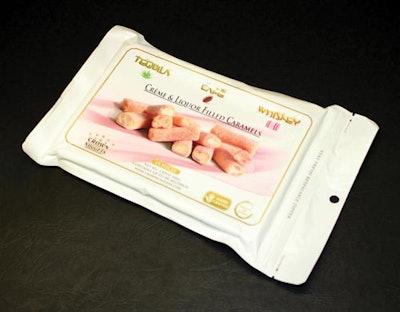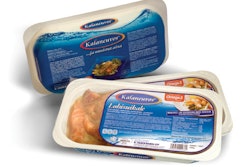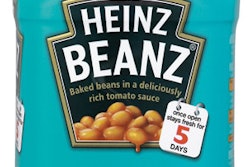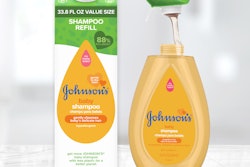
SPIRITED SWEETS. Crown Nuggets were invented in Mexico in 1946 by Antonio Aguas Bessera, when he combined his grandmothers candy
One of the biggest challenges for confectioners is maintaining the freshness of their products throughout the storage and distribution cycle. Anything that diminishes the consumer's perception of confectionery can damage the profitability of the product and the brand's image. Crown Candies, a purveyor of Mexican fine traditional sweets, faced this challenge when it had to find a way to maintain the texture of its famous Crown Nuggets for international distribution. When exposed to excess oxygen, the candy's soft texture can become dry, limiting its shelf life.
Crown Nuggets, known as "Borrachito" in the Mexican region of San Miguel de los Altos, Jalisco, where they were invented in 1946, are soft, crème-filled caramel nuggets infused with the flavor of Tequila. Today, the family of Borrachito inventor Antonio Aguas Bessera produces the candy in a range of flavors out of a facility called Dulces Típicos de Jalisco in Guadalajara, Mexico.
In 2007, Crown Companies LLC (Crown Candies), based in Atlanta, created Crown Nuggets, an export version of the candy, extending the Dulces Típicos de Jalisco supply chain to the U.S. The importation and distribution of Crown Nuggets brought a new challenge to the company: The candy had to retain its signature soft and fresh texture from the time it left the Guadalajara production line until it arrived at the U.S. distribution facility, and then during its transport to national retail destinations.
"We were finding that our product's exterior texture would become stale after two to three months, and we could not work out the cause," says Crown business development manager David Betts. "This resulted in product returns and an unfavorable market image. We had to find a way to retain our signature freshness and pillow-soft texture, and increase our shelf life."
Crown tried using food additives like polysorbate 80 (an emulsifier) and guar gum (a binder), as well as high-barrier metallized packaging. Although there was a slight improvement in the texture, the overall results were not what the company anticipated, and the use of preservatives was contrary to market preferences.
Scavenger eliminates stale product
It was during the 2009 Fancy Food Show in New York that an oxygen absorber was recommended to Crown as a potential solution. After some research, Crown selected Multisorb Technologies as a potential supplier.
Recalls Jonathan Quinn, business development representative at Multisorb, "During our initial conversations with Crown Candies, we were presented with two challenges: maintaining the soft texture of the candy and preserving its shelf life for shipping outside of Mexico."
Multisorb used its Calculations through OperationsSM (CtO) consultative evaluation and pseudo-empirical modeling methodology to identify the problem and quantify the solution. According to Quinn, CtO can speed time to market, often saving from six to 12 months of development time.
For the Crown project, Multisorb began by analyzing the candy to be packaged and predicted its stability when exposed to oxygen once packaged. The initial information from Crown indicated a loss of softness and sought a moisture-management solution. Quite logically, a loss of softness in a confection correlates with a loss of moisture. However, the analysis also included a review of the packaging used by Crown—a standard rigid film tray and lid, placed in a multilayer pouch—which was targeted as the cause of the problem. Due to the structure of the existing packaging, a significant amount of oxygen was trapped in the package once the candies were packed and sealed. This led to oxidation, likely related to the proteins in the formula, resulting in the hardening of the product.
"We then looked at the freshness and shelf-life objectives that Crown Candies had set and sent them a number of potential oxygen scavenger samples to place in some of their candy packages for testing purposes," says Quinn. "Crown Candies supplied the Multisorb team with candy samples, and we conducted our own internal tests on the product and packages both with and without the oxygen scavenger."
Based on the results, Multisorb recommended an oxygen scavenger in the form of a self-adhesive patch called FreshMax®, which can absorb both residual oxygen in the packaging and oxygen permeating through the packaging over time. The standard-size 30-cc label is supplied in a barrier pouch in strips of six for manual application; a continuous-spool format is available for use with automated application equipment.
Along with identifying a suitable oxygen scavenger, Multisorb also redesigned the candy package's film tray to include perforations that help eliminate trapped oxygen.
Multisorb then visited Crown's factory in Guadalajara to review the manufacturing process and ensure that the FreshMax scavengers were applied correctly to the interior of the film bag in which the Crown Nuggets were packaged. Says Betts, "This was an important step for us. It included some training for our staff on the production line, which boosted our quality control and added to the skill building of our employees."
Also significant for Crown was the fact that when they added the oxygen scavengers to their packaging in December 2009, they became pioneers in the Mexican market. Relates Betts, "We believe we are the first facility to use an oxygen scavenger in the Mexican market. This gives us a strong competitive advantage, as we are on the cutting edge of food safety and freshness."
FreshMax patches are now manually applied to all of Crown's candy packages, and provide up to a nine-month shelf life. Relates Quinn, as Crown's volume requirement increases, the company plans to automate the scavenger-application process.
The future looks sweet for Crown
Currently the Dulces Típicos de Jalisco facility produces 30,000 packages of Crown Nuggets per month over one shift, with the ability to increase production to 55,000 packs with the addition of a second shift.
Recently, the company began precursory discussions to obtain a Kosher certification for its products, which would open the company up to a multi-million dollar global market. It is also looking at expanding into the massive Eastern European market and is working on a launch strategy and new products aimed at local tastes.
"We were never able to penetrate markets outside of Guadalajara prior to introducing FreshMax into our supply chain," says Betts. "Now we are actively distributing our candy across the United States, and opportunities that we could not even think about before are now totally doable."
Crown Nuggets, known as "Borrachito" in the Mexican region of San Miguel de los Altos, Jalisco, where they were invented in 1946, are soft, crème-filled caramel nuggets infused with the flavor of Tequila. Today, the family of Borrachito inventor Antonio Aguas Bessera produces the candy in a range of flavors out of a facility called Dulces Típicos de Jalisco in Guadalajara, Mexico.
In 2007, Crown Companies LLC (Crown Candies), based in Atlanta, created Crown Nuggets, an export version of the candy, extending the Dulces Típicos de Jalisco supply chain to the U.S. The importation and distribution of Crown Nuggets brought a new challenge to the company: The candy had to retain its signature soft and fresh texture from the time it left the Guadalajara production line until it arrived at the U.S. distribution facility, and then during its transport to national retail destinations.
"We were finding that our product's exterior texture would become stale after two to three months, and we could not work out the cause," says Crown business development manager David Betts. "This resulted in product returns and an unfavorable market image. We had to find a way to retain our signature freshness and pillow-soft texture, and increase our shelf life."
Crown tried using food additives like polysorbate 80 (an emulsifier) and guar gum (a binder), as well as high-barrier metallized packaging. Although there was a slight improvement in the texture, the overall results were not what the company anticipated, and the use of preservatives was contrary to market preferences.
Scavenger eliminates stale product
It was during the 2009 Fancy Food Show in New York that an oxygen absorber was recommended to Crown as a potential solution. After some research, Crown selected Multisorb Technologies as a potential supplier.
Recalls Jonathan Quinn, business development representative at Multisorb, "During our initial conversations with Crown Candies, we were presented with two challenges: maintaining the soft texture of the candy and preserving its shelf life for shipping outside of Mexico."
Multisorb used its Calculations through OperationsSM (CtO) consultative evaluation and pseudo-empirical modeling methodology to identify the problem and quantify the solution. According to Quinn, CtO can speed time to market, often saving from six to 12 months of development time.
For the Crown project, Multisorb began by analyzing the candy to be packaged and predicted its stability when exposed to oxygen once packaged. The initial information from Crown indicated a loss of softness and sought a moisture-management solution. Quite logically, a loss of softness in a confection correlates with a loss of moisture. However, the analysis also included a review of the packaging used by Crown—a standard rigid film tray and lid, placed in a multilayer pouch—which was targeted as the cause of the problem. Due to the structure of the existing packaging, a significant amount of oxygen was trapped in the package once the candies were packed and sealed. This led to oxidation, likely related to the proteins in the formula, resulting in the hardening of the product.
"We then looked at the freshness and shelf-life objectives that Crown Candies had set and sent them a number of potential oxygen scavenger samples to place in some of their candy packages for testing purposes," says Quinn. "Crown Candies supplied the Multisorb team with candy samples, and we conducted our own internal tests on the product and packages both with and without the oxygen scavenger."
Based on the results, Multisorb recommended an oxygen scavenger in the form of a self-adhesive patch called FreshMax®, which can absorb both residual oxygen in the packaging and oxygen permeating through the packaging over time. The standard-size 30-cc label is supplied in a barrier pouch in strips of six for manual application; a continuous-spool format is available for use with automated application equipment.
Along with identifying a suitable oxygen scavenger, Multisorb also redesigned the candy package's film tray to include perforations that help eliminate trapped oxygen.
Multisorb then visited Crown's factory in Guadalajara to review the manufacturing process and ensure that the FreshMax scavengers were applied correctly to the interior of the film bag in which the Crown Nuggets were packaged. Says Betts, "This was an important step for us. It included some training for our staff on the production line, which boosted our quality control and added to the skill building of our employees."
Also significant for Crown was the fact that when they added the oxygen scavengers to their packaging in December 2009, they became pioneers in the Mexican market. Relates Betts, "We believe we are the first facility to use an oxygen scavenger in the Mexican market. This gives us a strong competitive advantage, as we are on the cutting edge of food safety and freshness."
FreshMax patches are now manually applied to all of Crown's candy packages, and provide up to a nine-month shelf life. Relates Quinn, as Crown's volume requirement increases, the company plans to automate the scavenger-application process.
The future looks sweet for Crown
Currently the Dulces Típicos de Jalisco facility produces 30,000 packages of Crown Nuggets per month over one shift, with the ability to increase production to 55,000 packs with the addition of a second shift.
Recently, the company began precursory discussions to obtain a Kosher certification for its products, which would open the company up to a multi-million dollar global market. It is also looking at expanding into the massive Eastern European market and is working on a launch strategy and new products aimed at local tastes.
"We were never able to penetrate markets outside of Guadalajara prior to introducing FreshMax into our supply chain," says Betts. "Now we are actively distributing our candy across the United States, and opportunities that we could not even think about before are now totally doable."
Companies in this article























